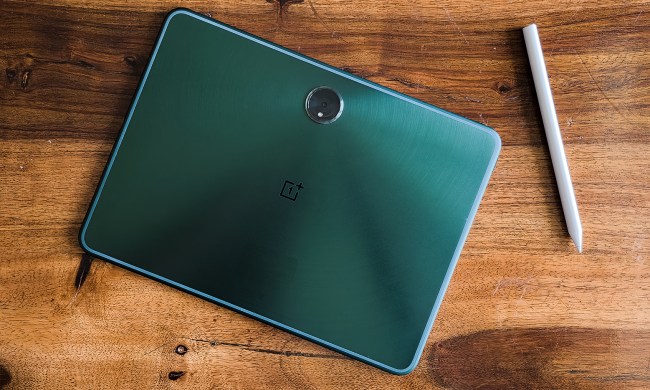“Xiaomi's Mi Pad 3 excels at the essentials, but is overshadowed by Apple’s cheap new iPad.”
- Hits the tablet size sweet spot at 7.9-inches
- High-resolution screen
- Attractive design
- Frustrating software and operation quirks
- Mediocre camera
“Why you can trust Digital Trends – We have a 20-year history of testing, reviewing, and rating products, services and apps to help you make a sound buying decision. Find out more about how we test and score products .“
Do tablets still have a place in the world? They’re not the trend they once were, and even Apple — the one company making tablets that sell in any quantity — has dropped the price on its 2017 entry-level iPad model to encourage people to buy or upgrade. At $330, the iPad is an all-around affordable option, but you’ll have to search for an Android tablet if you want something cheaper.
Xiaomi has released a new version of its Mi Pad, called the Mi Pad 3. It’s an iPad Mini-sized device with Xiaomi’s MIUI user interface over the top of Google’s operating system. It’s cheaper than the iPad Mini 4 and the new iPad, at around $270; but you’ll have to import one if you want it in the U.S.
Is it worth the import? No. While there’s nothing horribly wrong with the Mi Pad 3, its small quirks and issues do not justify the $270 price tag, especially when the new iPad is just $60 more. Let’s take a closer look.
This looks familiar
What does the Mi Pad 3 look like? Well, picture an iPad Mini 4 without the Apple branding, and you’re pretty much there. The two are shockingly similar. The 6.9mm thick aluminum body has a flat back with a camera lens in the top right, the corners are smooth and rounded, and the overall dimensions are almost identical. The screen is the same size at 7.9-inches, as is the 2048 x 1536 pixel resolution.
There are some differences. The dual speakers are mounted on the back of the tablet, facing away from you when looking at the screen, and the sleep/wake button is on the side of the body, not the top. It doesn’t have a fingerprint sensor, or any physical home button — instead the Mi Pad 3 uses capacitive navigational icons below the screen. We miss the tactility of a physical home button, largely because the Android keys aren’t especially responsive, and do require very precise taps to operate.
It’s a comfortable device to hold, and those with average or larger hands will have no problem holding it in one hand, thanks to its low weight. The texture on the back is pleasant to touch, but although the Mi Pad 3 is beautifully made, there is a slight flex in the center of the aluminium back panel. It’s not enough to cause concern, but enough to notice when it’s pressed.
There’s little to fault the way the Mi Pad 3 looks, mainly because it’s very close to the established and attractive style of the iPad Mini. It’s not something that overly concerns us — styling it after something hideous would do that — and we find the smaller 7.9-inch tablet size to be convenient, while still being suitably larger than our phone to make using it worthwhile.
Crisp screen that needs better color calibration
Xiaomi’s Mi Pad 3 has a 7.9-inch, 2048 x 1536 pixel, IPS LCD screen on the front, which is good enough for a 326 pixel-per-inch density, and a wide 178-degree viewing angle. It’s very bright, and we rarely needed to increase the brightness over 50 percent, which is good for battery life.
There’s a reading mode for nighttime use, which lowers the amount of sleep-damaging blue light emitted by the screen. It’s easily activated from the Android notification shade, and adds a yellowish look to the display, but there’s a slider to adjust the degree of intrusion. Dig through the menu and you’ll find an unusual black and white mode, which not only extends the battery life, but does a decent job of reducing eye strain when reading.
The Mi Pad 3’s size really does make it a great video-consuming machine.
The screen’s color and contrast can be tweaked under a separate menu, and we found it was worth taking the time to calibrate. Out of the box, in standard configuration, the whites didn’t appear crisp enough; but things improved when the display was switched to “cool.” Everyone will see it differently, which is why we welcome the chance to tailor the display’s look to our own taste.
Playing HD video from Netflix and Crunchyroll produced great images filled with color, and while we enjoyed the viewing experience, the 4:3 aspect ratio adds black bars to the top and bottom of most videos. Still, the Mi Pad 3’s size really does make it a great video-consuming machine. It’s not too big that it’s annoying to hold, but is still much more watchable than a 5.5-inch screen on a phone. Text looks excellent — crisp and well-defined — especially when browsing the web and reading ebooks.
The screen looks great, but we have one annoyance. The tablet doesn’t compensate for your palm resting on one side while scrolling with another finger. At first, it’s like the touchscreen isn’t working at all, then you realize it’s because the hand you’re holding the tablet with is also touching the edge of the screen. Remove it, and everything’s fine. Other times, it can activate certain features. It depends on how you’re holding the Mi Pad 3 — so doesn’t happen all the time — but when it does it’s highly irritating.
Fluid software, few tablet-friendly apps
Our Mi Pad 3 came with Android 7.0 Nougat installed, complete with an Android security patch from February, and Xiaomi’s global MIUI version 8.2, so everything is in English. Google Play and associated apps came pre-installed on our imported Mi Pad 3, along with a variety of standard apps including a calendar, a weather app, a calculator, an FM radio, and a browser.
Surprisingly, the tablet offers a slightly different user experience to a Xiaomi phone. Because it’s very smooth, and MIUI is supremely uncluttered, the tablet has a very Apple-like feel to it. The menus aren’t messy and it’s not filled with superfluous apps, making fast, daily use a pleasure. The most obvious additional feature Xiaomi has added is a widget page, viewable by swiping right on the main home screen. The widgets can be altered to your preference, making it a handy and attractively presented shortcut page.
Using Netflix, YouTube, popular games, Google apps, and several big-name social network apps downloaded from the Google Play store provide a tablet-friendly experience, but stray too far from the best known apps, and things aren’t so good. You don’t even have to look that hard either, the Instagram app doesn’t feel like it has been adapted for use on a tablet very well, for example. The more obscure, or dated, your favourite app is, the less likely it’ll look that fantastic on the Mi Pad 3. This isn’t a problem with the device, but a problem with Android on tablets as a whole.
There are other quirks unique to the Mi Pad 3. Even though it runs Android 7.0 Nougat, there’s no split window multi-tasking available with MIUI 8.
Adequate performance
Xiaomi previously used an Intel processor for its Mi Pad tablet, but this time it has chosen a MediaTek chip — the MT8176 — to power its slate, along with 4GB of RAM and 32GB of internal storage space. It’s not a common processor, having been used in few mainstream tablets sold in the U.S. and Europe.
Put through some benchmarking workouts, the scores are uninspiring.
In our general use, the MediaTek chip performed adequately, happily powering games such as Danmaku Unlimited in HD mode, and casual titles like Crossy Road . Graphically-intensive and faster-paced games like Reckless Racing put some strain on the tablet, and slow downs did occur. Put it through some benchmarking workouts, and the scores are uninspiring. AnTuTu returned a score of 74,646, and 3DMark’s Sling Shot Extreme gave it just 749. The Intel Atom-powered Lenovo Yoga Book managed 1,192, for comparison.
Unfortunately, there’s no MicroSD memory expansion, and 32GB of internal memory isn’t very much. Be prepared to slim down movie and music collections stored on the device itself, or stick with streaming services. There is a 3.5mm headphone socket though, and the 6,600mAh battery is charged through a USB Type-C port. We’ve been using the Mi Pad 3 for almost two weeks, and it has needed charging twice, not including the initial charge. Leaving it on standby overnight saw around 7 or 8-percent of the battery disappear.
Mediocre camera
The rear camera on the Mi Pad 3 is packed with 13 megapixels, autofocus, and an f/2.2 aperture. It’s highly unlikely the Mi Pad 3 will ever be someone’s primary camera, and it’s probably a good thing. The pictures it takes are only acceptable, and nothing more. Colors do pop, and plenty of detail is revealed zooming in on close-up images; but it doesn’t have an HDR mode, and overcast skies were washed out. Around the front, there’s a 5-megapixel camera with the same aperture, and it’s good for video calls and selfies.
Warranty, availability, and price
The Xiaomi Mi Pad 3 isn’t sold in the U.S. or Europe, and must be imported through a specialist. Our review Mi Pad 3 was supplied by Geekbuying, a well-known importer of Chinese electronics. At the time of writing it costs $270 with free shipping . The tablet was sent to us with a courier, did attract a small customs charge in the U.K., and arrived securely packaged.
Geekbuying offers a one-year warranty on the products it sells, including tablets, but doesn’t cover them if there has been water damage, mistreatment, or abuse. It’ll repair returned hardware for free within the warranty period, and has a warehouse in California that can be used instead of sending the device back to China. To take advantage of this, a $3 charge has to be paid at checkout during the original purchase. There’s also an English-speaking customer service helpline available.
Our Take
Unlike the company’s smartphones and their lack of wide U.S. network support, the Mi Pad 3 is a premium Xiaomi product everyone can enjoy, and its screen is great for video and reading.
Is there a better alternative?
The Mi Pad 3’s natural competitor is the Apple iPad Mini 4 , which is at least $130 more; however, potential tablet buyers should really be looking at the new 2017 9.7-inch iPad , which starts at $330. That’s close enough to the Mi Pad 3’s price to make it attainable, and the iPad has a far more varied catalog of fully tablet-compatible apps that makes it a wiser choice if you’re planning to use the device a lot. We’d strongly recommend the iPad.
If you’d prefer not to buy an Apple product, our favourite Android tablet at the moment is the Galaxy Tab S3 , but this is more than twice the price of the Mi Pad 3. Outside of this, the world’s awash with mediocre to average Android tablets, including the $300 Samsung Galaxy Tab A and the Asus ZenPad Z10 , or even the $135 Amazon Fire 8 . We wouldn’t recommend any of them in particular, and feel the Mi Pad 3 is a more premium device that’s at least on a par with the Galaxy Tab A, provided you’re happy to import one.
How long will it last?
The Mi Pad 3 isn’t water resistant, but the body is well-built and the metal back won’t shatter if it gets accidentally knocked. That said, if you’re planning on handing the Mi pad 3 over to your kids, you may want to find a sturdy child-proof case. Xiaomi isn’t the fastest with supplying Android version updates, as they usually require its UI to be reworked first, which takes time. This does change if you’re happy to use Xiaomi beta releases though, but we doubt everyone will be happy to do so.
Tablets aren’t the same as phones, and rarely need replacing. A three-year old tablet is far more capable than a three-year old smartphone. Many tablet owners just want to play video, browse the web, and check social media accounts. For this, the Mi Pad 3 will last for some time.
Should you buy it?
No. There’s nothing horribly wrong with the pretty, fast, and capable Mi Pad 3, but with Apple offering the new iPad for only $330, there’s not much of a reason to go for the Mi Pad 3. If Apple is a dirty word in your household, then it’s a different story, and the Mi Pad 3 stacks up nicely against the many similar options out there.






















